RANS-Based Modelling of Turbulent Flow in Submarine Pipe Bends: Effect of Computational Mesh and Turbulence Modelling
Abstract
:1. Introduction
2. Numerical Methodology
2.1. Governing Equations
2.2. Turbulence Model
2.2.1. Standard k-ε Turbulence Model
2.2.2. Low-Reynolds k-ε Turbulence Model
2.2.3. Nonlinear Viscosity Turbulence Model
2.3. Computational Domain and Mesh
2.4. Boundary Conditions
3. Effect of Computational Mesh and Turbulence Modeling
3.1. Parameters Used in Benchmarking
3.2. Types of Computational Meshes
3.3. Grid Sensitivity Analysis
3.4. Considerations of Computational Effort
3.5. Influence of Curvature Ratio and Reynolds Number
4. Conclusions
- (1)
- Computational mesh has a certain impact on those critical variables concerned in this study. The most sensitive variable regarding turbulent pipe bend flow was turbulent kinetic energy. The sensitivity of the turbulence intensity to mesh sizes also relies on the application of the turbulence model (Figure 3 and Figure 4). The sensitivity of mesh sizes on the turbulence kinetic energy can be reduced, provided that the boundary layer is fully resolved, especially for the configurations where the turbulence model based on the nonlinear eddy viscosity hypothesis is utilized, combined with unstructured mesh and structured mesh with a nonuniform inflation layer.
- (2)
- (3)
- The influence of mesh types on turbulence intensity is remarkable (Figure 9), as the smaller peak value and the gradient close to the near wall were captured by structured mesh with a uniform inflation layer when it comes to y+ of 30, compared with another two meshes. However, the fully resolved boundary layer seemed not to improve the results since the gradient and peak value near the inner wall had not been detected. The reason for this will be investigated in future work.
- (4)
- (5)
Author Contributions
Funding
Institutional Review Board Statement
Informed Consent Statement
Data Availability Statement
Conflicts of Interest
Nomenclature
| i: j, k | indices of structured grid |
| z, z’ | longitudinal distance along the pipe axis |
| θ, r | azimuthal coordinate and radial coordinate |
| d | pipe diameter |
| R | pipe radius |
| Rc | curvature radius of pipe bend |
| φ | angle from the bend inlet |
| Lup, Ldown | length of upstream and downstream straight pipe |
| U, V, W | time-averaged velocity in three directions |
| u’, v’, w’ | fluctuating velocity in three directions |
| k | turbulent kinetic energy (TKE) |
| ε, | dissipation rate of TKE |
| Pk | production of TKE |
| ρ | density of fluid |
| ν | kinetic viscosity of the fluid |
| νt | turbulent viscosity of the fluid |
| , , , | coefficients in the turbulence model |
| f1, f2, E | damping coefficients and source term in the turbulence model |
| Win, kin, | velocity, TKE, and dissipation rate of TKE at the inlet |
| g | gravitational acceleration |
| Re | Reynolds number |
| Pa | static pressure at any position |
| Pref | reference value of Pa |
| Pr | relative air pressure |
| general variable | |
| n | normal vector of cell surface |
| Cp | pressure coefficient, Cp = (Pa-Pref)/(ρWin2/2) |
| Is | secondary flow intensity |
| ka | turbulence intensity |
References
- He, X.L.; Sourabh, V.A.; Shashank, K.K.; Ömer, N.D. An LES study of secondary motion and wall shear stresses in a pipe bend. Phys. Fluids 2021, 33, 115102. [Google Scholar] [CrossRef]
- Wegt, S.; Maduta, R.; Kissing, J.; Hussong, J.; Jakirlić, S. LES-based vortical flow characterization in a 90°-turned pipe bend. Comput. Fluids 2022, 240, 105418. [Google Scholar] [CrossRef]
- Dean, W.R. Note on the motion of fluid in a curved pipe. Philos. Mag. 1927, 4, 208–223. [Google Scholar] [CrossRef]
- Sudo, K.; Sumida, H.; Hibara, H. Experimental investigation on turbulent flow in a circular-sectioned 90-degree bend. Exp. Fluids 1998, 25, 42–49. [Google Scholar] [CrossRef]
- Weske, J.R. Experimental Investigation of Velocity Distributions Downstream of Single Duct Bends; Report No. NACA-TN-1471; National Advisory Committee for Aeronautics: Boston, MA, USA, 1948. [Google Scholar]
- Hellström, L.H.O.; Sinha, A.; Smits, A.J. Visualizing the Very-Large-Scale motions in turbulent pipe flow. Phys. Fluids 2011, 23, 011703. [Google Scholar] [CrossRef]
- Vester, A.K.; Örlü, R.; Alfredsson, P.H. Turbulent flows in curved pipes: Recent advances in experiments and simulations. Appl. Mech. Rev. 2016, 68, 050802. [Google Scholar] [CrossRef]
- Weisbach, J. Experimentelle Hydraulik; Engelhardt: Freiberg, Germany, 1855. [Google Scholar]
- Thomson, J. On the origin of windings of rivers in alluvial plains with remarks on the flow of water round bends in pipes. Proc. R. Soc. Lond. 1876, 25, 5–8. [Google Scholar]
- Thomson, J. Experimental demonstration in respect to the origin of windings of rivers in alluvial plains, and to the mode of flow of water round bends of pipes. Proc. R. Soc. Lond. 1877, 26, 356–357. [Google Scholar]
- Williams, G.S.; Hubbell, C.W.; Fenkell, G.H. Experiments at Detroit, MI, on the Effect of curvature upon the flow of water in pipes. Trans. Am. Soc. Civ. Eng. 1902, 47, 1–196. [Google Scholar] [CrossRef]
- Eustice, J. Flow of water in curved pipes. Proc. R. Soc. Lond. 1910, 84, 107–118. [Google Scholar]
- Eustice, J. Experiments on stream-line motion in curved pipes. Proc. R. Soc. Lond. 1911, 85, 119–131. [Google Scholar]
- Dean, W.R. The stream-line motion of fluid in a curved pipe. Philos. Mag. 1928, 5, 671–695. [Google Scholar] [CrossRef]
- Adler, M. Strömung in gekrümmten Rohren. J. Appl. Math. Mech. Z. Angew. Math. Mech. 1934, 14, 257–275. [Google Scholar] [CrossRef]
- Rowe, M. Measurements and computations of flow in pipes. J. Fluid Mech. 1998, 43, 771–783. [Google Scholar] [CrossRef] [Green Version]
- Anwer, M.; So, R.M.C.; Lai, Y.G. Perturbation by and recovery from bend curvature of a fully developed turbulent pipe flow. Phys. Fluids A Fluid Dyn. 1989, 1, 1387. [Google Scholar] [CrossRef]
- Enayet, M.M.; Gibson, M.M.; Taylor, A.M.K.P.; Yianneskis, M. Laser Doppler measurements of laminar and turbulent flow in a pipe bend. Int. J. Heat Fluid Flow 1982, 3, 213–219. [Google Scholar] [CrossRef]
- Azzola, J.; Humprey, J.A.C.; Iacovides, H.; Launder, B.E. Developing turbulent flow in a U-bend of circular cross-section: Measurement and computation. ASME J. Fluids Eng. 1986, 108, 214–221. [Google Scholar] [CrossRef]
- Patankar, S.V.; Pratap, V.S.; Spalding, D.B. Prediction of turbulent flow in curved pipes. J. Fluid Mech. 1975, 67, 583–595. [Google Scholar] [CrossRef]
- Rowe, M. Some Secondary Flow Problems in Fluid Dynamics. Ph.D. Thesis, Cambridge University, Cambridge, UK, 1966. [Google Scholar]
- Al-Rafai, W.N.; Tridimas, Y.D.; Woolley, N.H. A study of turbulent flows in pipe bends. Proc. Inst. Mech. Eng. Part C J. Mech. Eng. Sci. 1990, 204, 399–408. [Google Scholar] [CrossRef]
- Lai, Y.; So, R.M.C.; Zhang, H.S. Turbulence-driven secondary flows in a curved pipe. Theor. Comput. Fluid Dyn. 1991, 3, 163–180. [Google Scholar] [CrossRef]
- Wang, J.R.; Shirazi, S.A. A CFD based correlation for mass transfer coefficient in elbows. Int. J. Heat Mass Transf. 2001, 44, 1817–1822. [Google Scholar] [CrossRef]
- Pruvost, J.; Legrand, J.; Legentilhomme, P. Numerical investigation of bend and torus flows—Part I: Effect of swirl motion on flow structure in U-bend. Chem. Eng. Sci. 2004, 59, 3345–3357. [Google Scholar] [CrossRef]
- Hilgenstock, A.; Ernst, R. Analysis of installation effects by means of Computational Fluid Dynamics—CFD versus experiments? Flow Meas. Instrum. 1996, 7, 161–171. [Google Scholar] [CrossRef]
- Kim, J.; Yadav, M.; Kim, S. Characteristics of secondary flow induced by 90-degree elbow in turbulent pipe flow. Eng. Appl. Comput. Fluid Mech. 2014, 8, 229–239. [Google Scholar] [CrossRef] [Green Version]
- Wang, L.W.; Gao, D.R.; Zhang, Y.G. Numerical simulation of turbulent flow of hydraulic oil through 90° circular-sectional bend. Chin. J. Mech. Eng. 2012, 25, 905–910. (In Chinese) [Google Scholar] [CrossRef]
- Chen, M.; Zhang, Z.G. Numerical simulation of turbulent driven secondary flow in a 90° bend pipe. Adv. Mater. Res. 2013, 765–767, 514–519. [Google Scholar] [CrossRef]
- Dutta, P.; Saha, S.K.; Nandi, N. Numerical study on flow separation in 90° pipe bend under high Reynolds number by k-ε modelling. Eng. Sci. Technol. Int. J. 2016, 19, 904–910. [Google Scholar] [CrossRef]
- Hossain, S.; Hossain, I. Computational investigation of turbulent flow development in 180° channel with circular cross section. Eur. J. Eng. Res. Sci. 2018, 3, 98–105. [Google Scholar] [CrossRef]
- Dutta, P.; Saha, S.K.; Nandi, N. Numerical study of curvature effect of turbulent flow in 90° pipe bend. In Proceedings of the ICTACEM 2014 International Conference on Theoretical, Applied, Computational and Experimental Mechanics, IIT, Kharagpur, India, 29–31 December 2014. [Google Scholar]
- Chowdhury, R.R.; Alam, M.M.; Sadrul Islam, A.K.M. Numerical modeling of turbulent flow through bend pipes. Mech. Eng. Res. J. 2016, 10, 14–19. [Google Scholar]
- Ayala, M.; Cimbala, J.M. Numerical approach for prediction of turbulent flow resistance coefficient of 90° pipe bends. Proc. Inst. Mech. Eng. Part E J. Process Mech. Eng. 2020, 235, 351–360. [Google Scholar] [CrossRef]
- Jurga, A.P.; Janocha, M.J.; Yin, G.; Ong, M.C. Numerical simulations of turbulent flow through a 90-deg pipe bend. J. Offshore Mech. Arct. Eng. 2022, 144, 061801. [Google Scholar] [CrossRef]
- Zhang, J.; Wang, D.; Wang, W.; Zhu, Z. Numerical investigation and optimization of the flow characteristics of bend pipe with different bending angles. Processes 2022, 10, 1510. [Google Scholar] [CrossRef]
- Yin, G.; Ong, M.C.; Zhang, P.Y. Numerical investigations of pipe flow downstream a flow conditioner with bundle of tubes. Eng. Appl. Comput. Fluid Mech. 2023, 17, e2154850. [Google Scholar] [CrossRef]
- Launder, B.E.; Spalding, D.B. The numerical computation of turbulent flows. Comput. Methods Appl. Mech. Eng. 1974, 3, 269–289. [Google Scholar] [CrossRef]
- Launder, B.E.; Sharma, B.I. Application of the energy-dissipation model of turbulence to the calculation of flow near a spinning disc. Lett. Heat Mass Transf. 1974, 1, 131–137. [Google Scholar] [CrossRef]
- Lien, F.S.; Chen, W.L.; Leschziner, M.A. Low-Reynolds-number eddy-viscosity modeling based on non-linear stress-strain/vorticity relations. Eng. Turbul. Model. Exp. 1996, 3, 91–100. [Google Scholar]

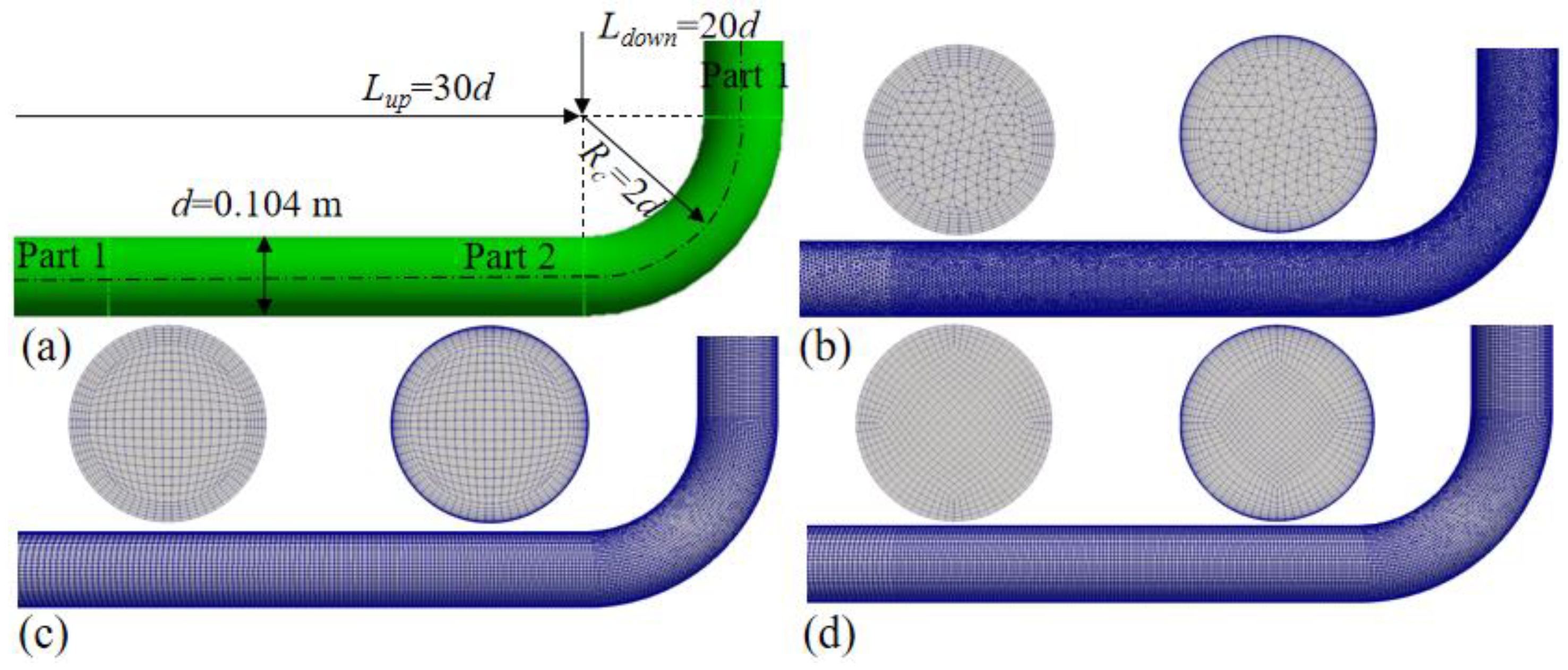


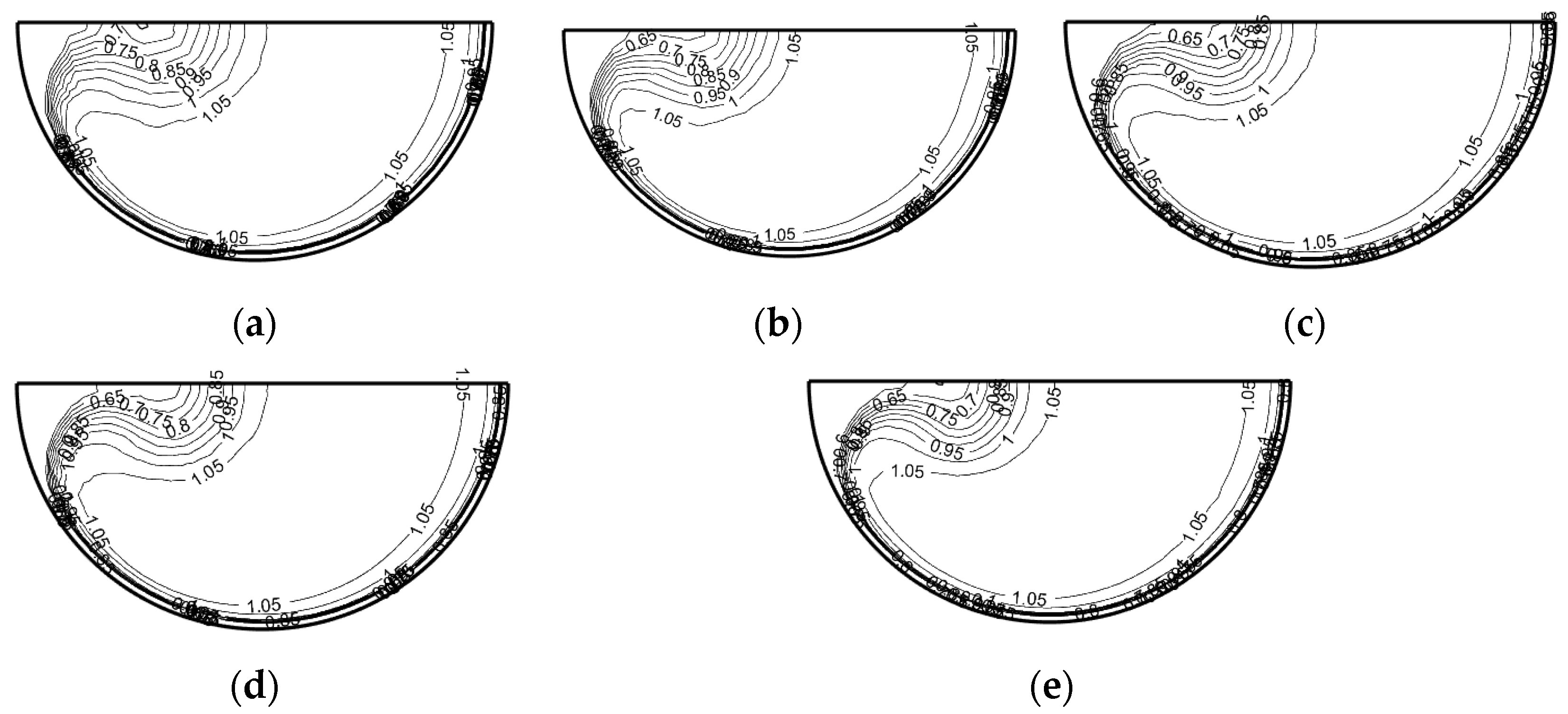

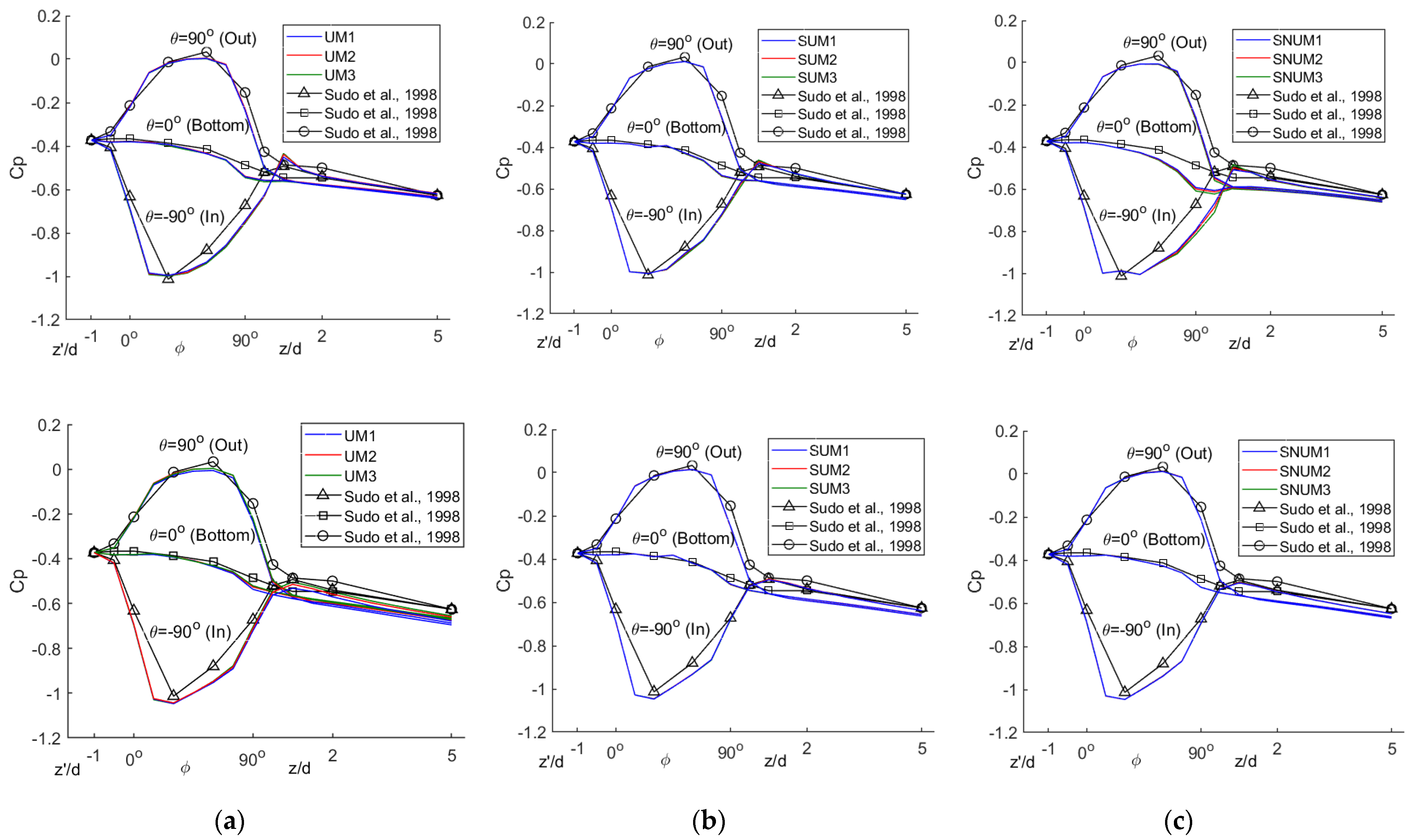



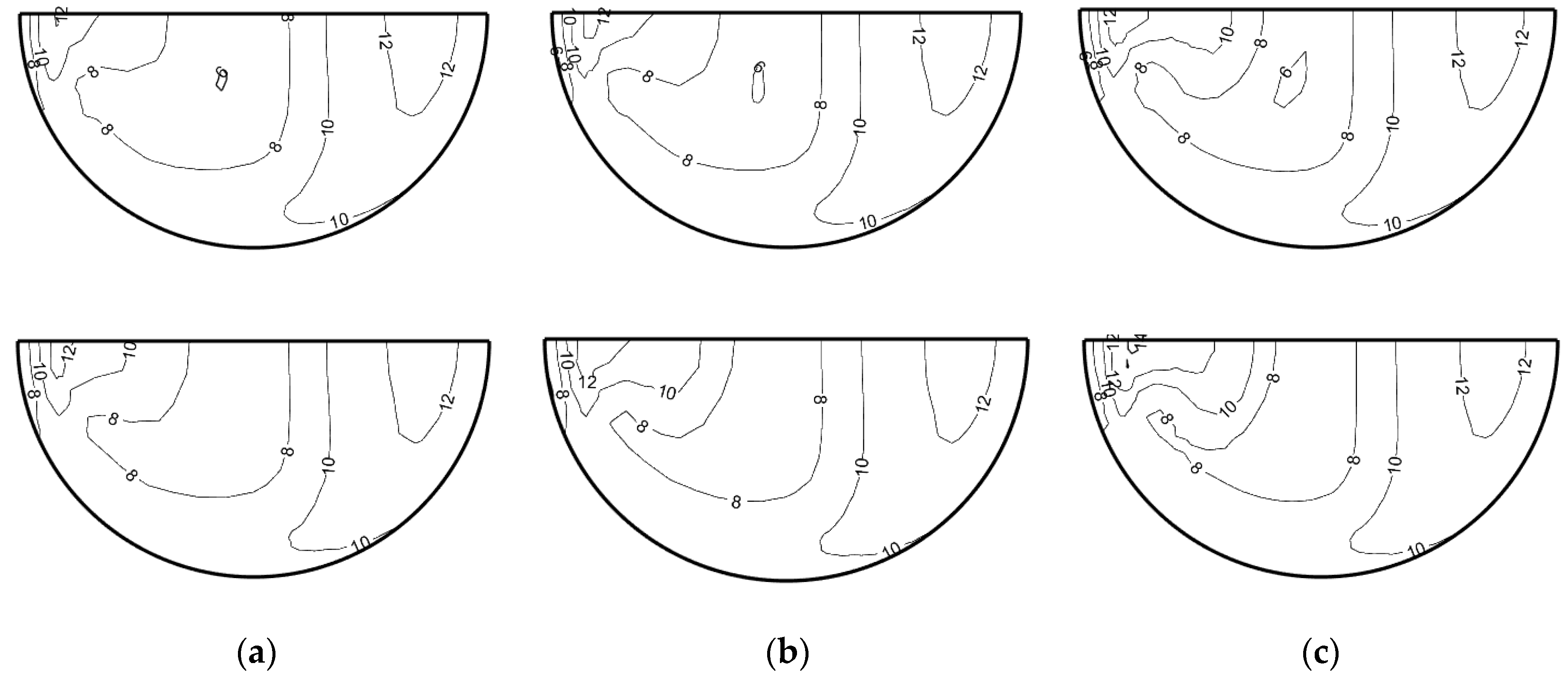
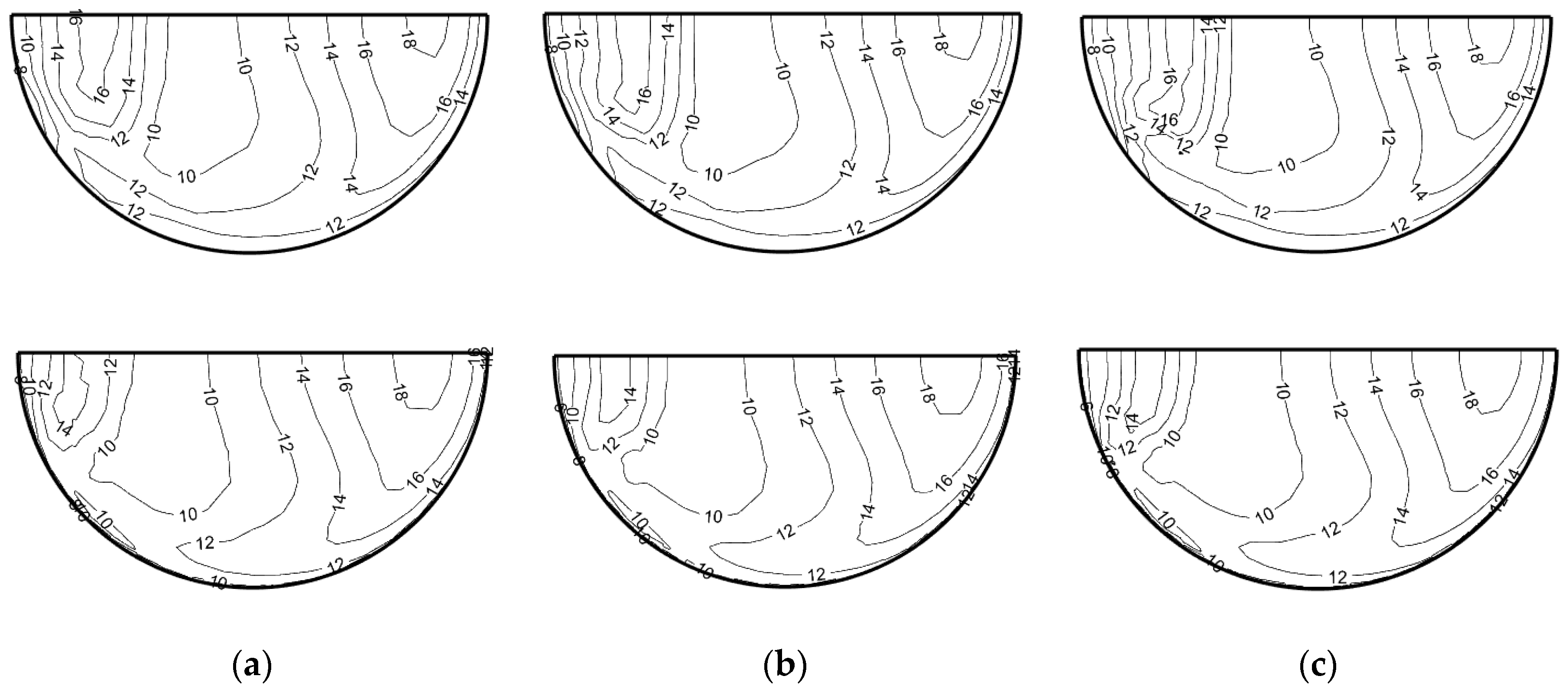
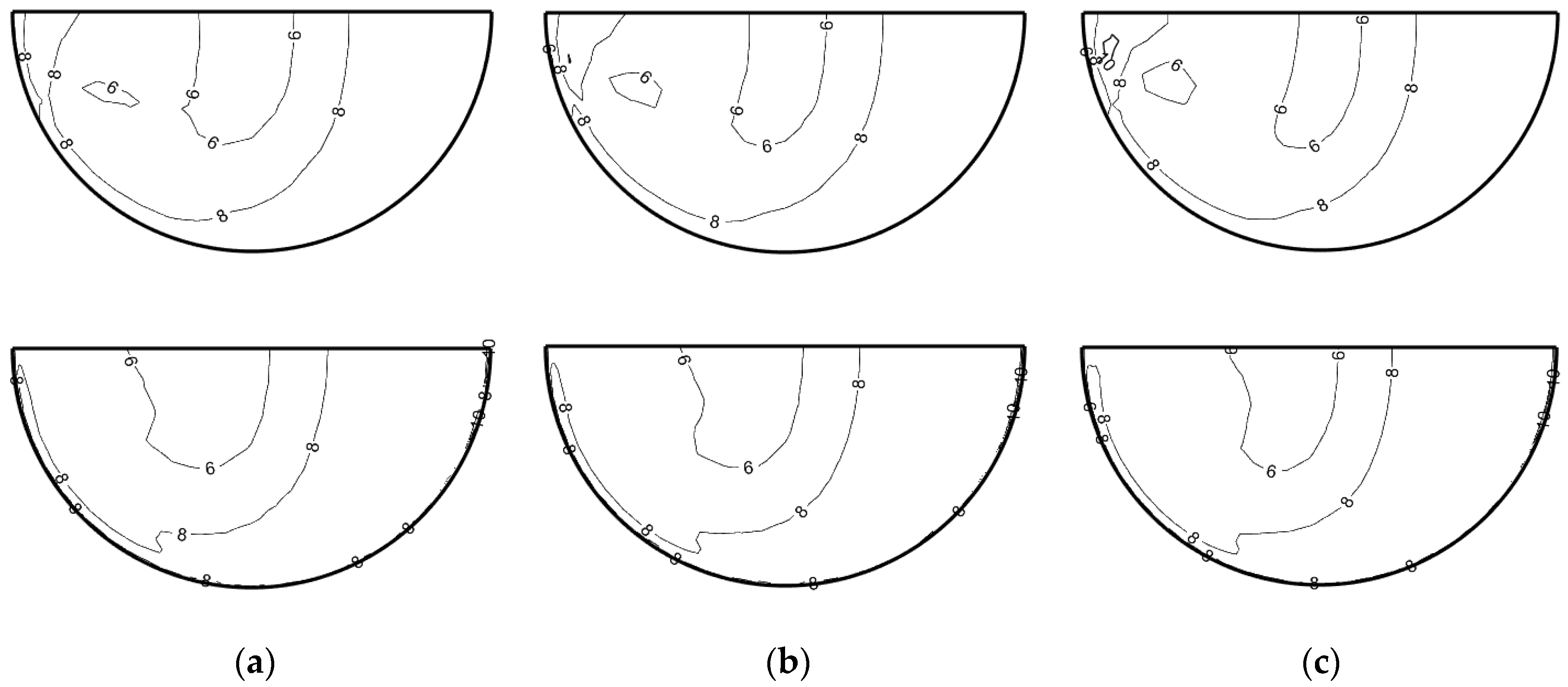


| S | ||||
|---|---|---|---|---|
| 1.44 | 1.92 | 0.09 | 1 | 1.3 |
| 1 | ||||||
| 1.44 | 0.92 | 0.09 | 1 | 1.22 |
| () | ||||||||
| + | ||||||||
| Mesh Types | Abbreviation | The Cell Size of Part 1 (m) | The Cell Size of Part 2 (m) | Number of Inflation Layer | Growth Ratio of Inflation Layer | Total Cells Number | Average Nonorthogonality | Max Skewness | |||||
|---|---|---|---|---|---|---|---|---|---|---|---|---|---|
| y+ = 30 | y+ = 1 | y+ = 30 | y+ = 1 | y+ = 30 | y+ = 1 | y+ = 30 | y+ = 1 | y+ = 30 | y+ = 1 | ||||
| Unstructured mesh | UM1 | 0.0095 | 0.007 | 5 | 14 | 1.05 | 1.325 | 713,135 | 1,260,911 | 12.46 | 9.54 | 0.745 | 0.756 |
| UM2 | 0.008 | 0.006 | 1,093,009 | 1,843,736 | 12.74 | 9.83 | 0.736 | 0.791 | |||||
| UM3 | 0.0065 | 0.005 | 1,843,134 | 2,935,319 | 12.99 | 10.22 | 0.862 | 0.780 | |||||
| UM4 | 0.0055 | 0.004 | 3,054,005 | - | 13.19 | - | 0.803 | - | |||||
| UM5 | 0.004 | 0.003 | 5,066,295 | - | 13.59 | - | 0.843 | - | |||||
| Structured mesh with uniform inflation layer | SUM1 | 0.0095 | 0.007 | 163,584 | 347,616 | 12.91 | 9.43 | 0.529 | 0.577 | ||||
| SUM2 | 0.008 | 0.006 | 241,808 | 497,840 | 13.38 | 9.67 | 0.594 | 0.64 | |||||
| SUM3 | 0.0065 | 0.005 | 377,400 | 744,600 | 13.98 | 10.13 | 0.67 | 0.711 | |||||
| Structured mesh with nonuniform inflation layer | SNUM1 | 0.0095 | 0.007 | 246,144 | 553,824 | 5.81 | 4.42 | 1.175 | 0.601 | ||||
| SNUM2 | 0.008 | 0.006 | 360,808 | 785,288 | 5.98 | 4.59 | 1.020 | 0.630 | |||||
| SNUM3 | 0.0065 | 0.005 | 579,309 | 1,205,589 | 6.20 | 4.81 | 0.837 | 0.715 | |||||
| SNUM4 | 0.0055 | 0.004 | 953,988 | - | 6.43 | - | 0.670 | - | |||||
| SNUM5 | 0.004 | 0.003 | 1,761,984 | - | 6.69 | - | 0.605 | - | |||||
Disclaimer/Publisher’s Note: The statements, opinions and data contained in all publications are solely those of the individual author(s) and contributor(s) and not of MDPI and/or the editor(s). MDPI and/or the editor(s) disclaim responsibility for any injury to people or property resulting from any ideas, methods, instructions or products referred to in the content. |
© 2023 by the authors. Licensee MDPI, Basel, Switzerland. This article is an open access article distributed under the terms and conditions of the Creative Commons Attribution (CC BY) license (https://creativecommons.org/licenses/by/4.0/).
Share and Cite
Yang, Q.; Dong, J.; Xing, T.; Zhang, Y.; Guan, Y.; Liu, X.; Tian, Y.; Yu, P. RANS-Based Modelling of Turbulent Flow in Submarine Pipe Bends: Effect of Computational Mesh and Turbulence Modelling. J. Mar. Sci. Eng. 2023, 11, 336. https://doi.org/10.3390/jmse11020336
Yang Q, Dong J, Xing T, Zhang Y, Guan Y, Liu X, Tian Y, Yu P. RANS-Based Modelling of Turbulent Flow in Submarine Pipe Bends: Effect of Computational Mesh and Turbulence Modelling. Journal of Marine Science and Engineering. 2023; 11(2):336. https://doi.org/10.3390/jmse11020336
Chicago/Turabian StyleYang, Qi, Jie Dong, Tongju Xing, Yi Zhang, Yong Guan, Xiaoli Liu, Ye Tian, and Peng Yu. 2023. "RANS-Based Modelling of Turbulent Flow in Submarine Pipe Bends: Effect of Computational Mesh and Turbulence Modelling" Journal of Marine Science and Engineering 11, no. 2: 336. https://doi.org/10.3390/jmse11020336






